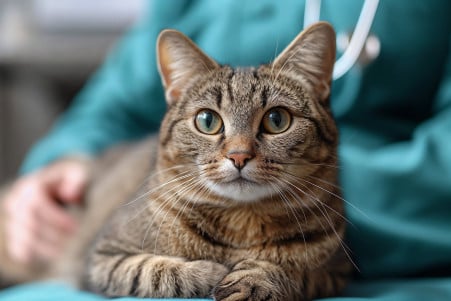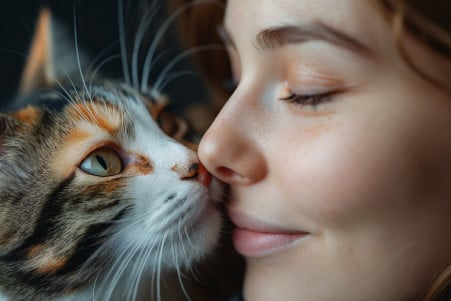Why Do Cats Chase Their Tails? Unraveling the Mystery
20 April 2024 • Updated 19 April 2024

If you’ve ever watched your cat chasing its tail, you may have asked yourself why it’s doing this. Cats chase their tails for a number of reasons, including predatory behavior, play, and even compulsive disorders. While kittens often chase their tails as they practice hunting skills, adult cats may do it out of curiosity, boredom, or to get some much-needed physical activity. That said, if your cat is chasing its tail obsessively, it may be a sign of an underlying medical condition or stress.
In this article, we’ll explore the findings of recent veterinary research and studies on feline behavior to explain why cats chase their tails. By learning more about the reasons behind tail-chasing and the factors that influence it, you can better understand your cat’s natural instincts and developmental stages. This, in turn, can help you form a stronger bond with your pet and ensure that you’re meeting their physical and emotional needs.
Why do cats chase their tails?
Kitten Play: Tail-Chasing as a Developmental Behavior
Tail chasing is a normal and natural behavior in kittens and young cats that occurs during play and while they are learning to hunt, according to Cat Tales. This behavior is part of their natural play and development and helps them develop their predatory instincts and physical coordination. Kittens may chase their tails because they are curious about them or because they have extra energy to burn, according to Your Cat.
That said, The Tiniest Tiger explains that if an adult cat chases its tail frequently, it may be a sign of an underlying medical or behavioral problem. Owners should keep an eye on how often and how intensely their adult cats chase their tails and talk to a vet if the behavior becomes too frequent or seems to be causing the cat distress, according to PetMD. While kittens' tail chasing is a sign of their developmental stage, if adult cats' tail chasing becomes a consistent focus, it may be a sign that they need to see a vet or that their environment needs to be adjusted.
Medical Matters: Health Conditions That May Cause Excessive Tail-Chasing
Excessive or sudden tail chasing in adult cats may be due to an underlying medical issue that needs to be addressed by a veterinarian, according to the Cornell University College of Veterinary Medicine. These issues may include skin problems such as irritations, allergies, infections, and parasites, or neurological conditions such as feline hyperesthesia syndrome.
Hyperesthesia is a condition in which cats experience increased sensitivity in their skin and exhibit signs of pain when they are touched, especially in the area of the back near the tail, per WebMD. Other medical problems such as injuries, anal gland issues, and nerve damage can also cause excessive tail-chasing or tail-biting, according to the Best Friends Animal Society.
Before looking into behavioral or psychological causes, it's important to rule out physical or medical causes, according to the Cornell University Hospital for Animals. To ensure that the cause of excessive tail-chasing in adult cats is properly identified and treated, it's important to work with a veterinarian.
Environmental Enrichment and Redirection
If medical causes have been ruled out, cats may be chasing their tails due to boredom, stress, or a lack of environmental enrichment, according to Feline Behavior Solutions. Environmental enrichment, interactive toys, and regular play sessions can help redirect a cat's focus and energy away from tail-chasing, according to Plunktales.
In addition, positive reinforcement, which involves rewarding positive behaviors with treats or affection, can be used to discourage tail-chasing, according to Small Door Veterinary. By distracting cats and redirecting their focus to other activities, pet parents can work to eliminate the behavior, according to PetHelpful.
Finally, if tail-chasing continues or becomes compulsive, pet parents can seek the help of a veterinary behaviorist or certified cat behavior consultant, according to The Dodo. With a focus on environmental enrichment and redirection, pet parents can work to discourage tail-chasing and encourage healthier behaviors.
When to See a Professional: Chronic Tail-Chasing and Compulsive Disorders
While some cats may chase their tails occasionally, chronic or obsessive tail-chasing in adult cats may be a sign of a more serious issue, notes VCA Animal Hospitals. The article explains that compulsive disorders, including psychogenic alopecia (excessive grooming) and tail-chasing, can be caused by anxiety, conflict, or environmental deprivation.
If a cat bites or otherwise injures its tail while chasing it, it can result in severe wounds or infections that may require medical treatment or amputation, cautions TribLIVE. Therefore, the article recommends that pet owners seek the help of a veterinarian or a certified animal behaviorist if their cat’s tail-chasing becomes a regular or intense behavior that leads to distress or self-harm, according to The Decatur Daily.
The article from VCA Animal Hospitals notes that treatment for compulsive tail-chasing in cats may involve a combination of behavioral modification, medication, and addressing the root causes of the disorder. As a result, pet owners can seek professional help to address the underlying causes of chronic or problematic tail-chasing in their cats.
Tail Tales: What to Know About Cats Chasing Their Tails
While tail chasing is a normal and natural behavior in kittens and young cats, it can be a sign of an underlying medical or behavioral issue in older cats. According to Cat Tales, tail chasing is a normal and natural behavior in kittens and young cats, and it can help them develop and practice their hunting skills. It is a normal part of play and development that helps cats develop their predatory instincts and improve their agility. Kittens may chase their tails because they are curious or have extra energy to burn, as reported by Your Cat.
On the other hand, tail chasing in older cats may be a sign of a medical or behavioral issue, according to The Tiniest Tiger. As a result, cat owners should keep an eye on how often their adult cats chase their tails and how distressed they seem to be while doing it and contact a vet if they are concerned, says PetMD.
If a medical issue is not found, environmental factors such as stress or boredom may be contributing to the behavior. Providing environmental enrichment, positive reinforcement, and addressing potential stress or boredom can help discourage excessive tail-chasing. Understanding the motivations and nuances of tail-chasing can foster a stronger human-animal bond and enable better care for a cat's overall well-being.


